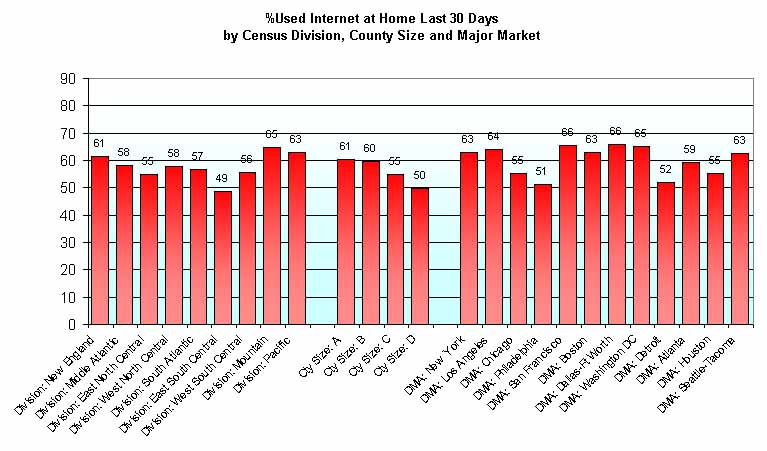
(Source: MARS 2005)
Spatial Distribution of Internet Users in the US
The temporal diffusion of Internet usage in the United States has been carefully tracked. By comparison, much less is known about the spatial distribution of Internet users. A priori, what would our expectations be?
Internet adoption is known to be correlated with income. In order to access the Internet from home, it is necessary to obtain a personal computer and then get a subscription service from an Internet service provider at a monthly cost typically between US$20 to US$40. Thus, internet usage is correlated with income. It is also known that Internet is correlated with education, as people with higher education are more likely to have been exposed before and also have the need to use the Internet for communication and information. To the extent that income and education are not homogeneously distributed across the United States, Internet adoption may not have a uniform spatial distribution.
We will now refer to some survey results from the 2005 MARS study. This is a mail survey of 21,216 adults in the United States conducted during the first quarter of 2005. The following chart shows the spatial distribution of Internet usage by the nine Census divisions, county size as defined by Nielsen Media Research and the top 12 Designated Market Areas as defined by Nielsen Media Research.
The United States is divided into approximately 3,300 counties with the following county size designations: (A) one of the largest 21 counties in the country; (B) metropolitan areas or more than 85,000 households according to the 2000 Census; (C) county which has more than 20,000 households or is part of a metropolitan area [MSA] that has more than 20,000 households; (D) county with less than 20,000 households. Internet usage is correlated with country size, with higher penetration in the large metropolitan areas.

(Source: MARS 2005)
There are various ways to access the Internet, including home, office, schools and public places (e.g. libraries, kiosks, cafes, etc). Still, it probably won't do to spend significant amounts of time hogging a public terminal. The most common mode is therefore access from home. The next chart shows the incidences of Internet usage at home.

(Source: MARS 2005)
Initially, intenet access from home was usually made through using telephone modems that work at low speed (at a maximum of 56 kbps). In time, the internet service providers were able to figure out that the telephone phone wire contains much larger capacity, and so an alternate DSL service could be provided without interfering with regular voice telephony. Meanwhile, cable television operators also realized that their cable wires could also be used to provide internet access, and satellite television providers could do the same. Collectively, these high-speed methods of internet access are known as broadband, in contrast to the low-speed narrowband access.
The following chart shows the shares of narrowband versus broadband usage by the geographical entities.

(Source: MARS 2005)
The share of broadband is higher in the harge metropolitan areas. This is the same with telephony. In the high-density urban areas, the telephone companies can lay down the fiber optic cables and know that they stand a reasonable chance to recuperate costs and even make profits. In the low-density rural areas, they know that there is no way to run a profitable operation, ever. To guarantee universal telephone access, the telephone companies charge higher in the urban areas to subsidise rural users. The subsidy was possible when telephony was a regulated monopoly. When cable television came along, the same situation exists, but there was no reason to guarantee universal access to an entertainment service. Thus, much of the rural America does not have cable television. Internet access is now following the historical path of cable television.
(posted by Roland Soong, 4/23/2005)
(Return to Zona Latina's Home Page)